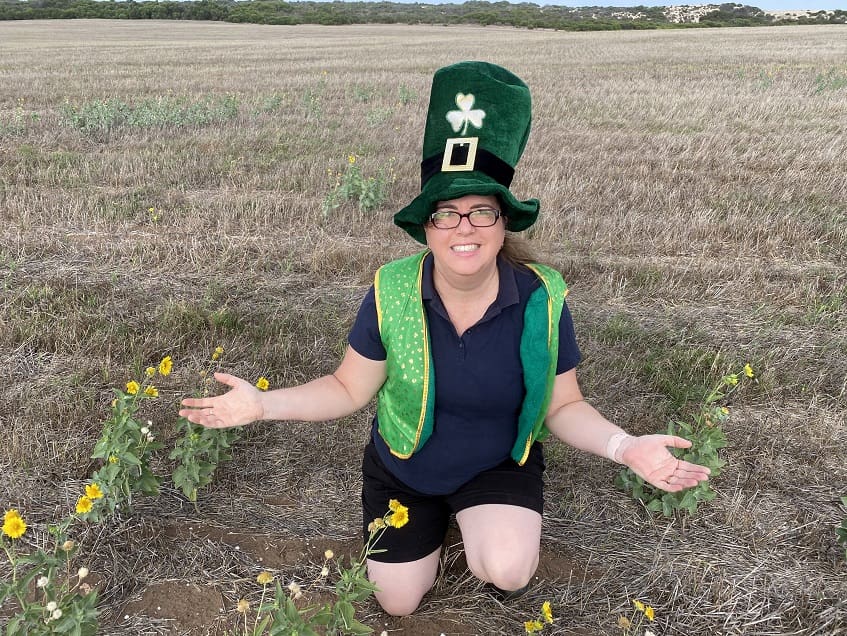
DPIRD research scientist Ciara Beard urges landholders to celebrate Saint Patrick’s Day by checking their paddocks for signs of pests and diseases on the weed and crop regrowth ‘green bridge’.
WESTERN Australian broadacre farmers who received recent rainfall are encouraged to join the leprechauns and check their paddocks for pests and diseases on the ‘green bridge’ around Saint Patrick’s Day on 17 March.
Survey efforts will not only inform weed and crop regrowth control measures but also contribute to a new crop disease surveillance project being undertaken by the WA Department of Primary Industries and Regional Development (DPIRD).
The project, which has co-investment from the Grains Research and Development Corporation (GRDC), aims to measure the presence of endemic diseases of cereals, oilseeds and pulses, as well as support surveillance for exotic pathogens.
The information will help to refine management strategies to reduce the impact of crop foliar diseases and increase crop profitability.
DPIRD research scientist Ciara Beard, who has Irish heritage, encouraged landholders to mark Saint Patrick’s Day – or thereabouts – by checking paddocks for regrowth plants and reporting any signs of aphids and diseases.
“This celebratory day is a great reminder to check paddocks for signs of disease, like cereal rusts and powdery mildew, which can be harboured on weeds and summer volunteers,” she said.
“Growers are encouraged to report any suspect findings via the department’s MyPestGuide – Crops Reporter or Pestfax Reporter apps so our staff can collect surveillance data and assist with diagnosis.
“In this way, rather than relying on the luck of the Irish, growers can be proactive by planning weed and disease control strategies and setting up their crops for a good growing season.”
The research project, which commenced last July, has already undertaken more than 250 surveys on commercial cropping properties from Northampton to Esperance during the 2019 season, with plans to undertake more over the next 12 months.
Paddock surveillance
DPIRD staff from around the grainbelt will also be undertaking paddock surveillance in coming weeks to support the research.
The surveillance, is being supported by extensive sampling to quantify the incidence and severity of endemic diseases and checking for new pathotypes across the grainbelt.
“The project also includes spore trapping in the lower Great Southern and Albany port zone, to provide an early warning of risk for diseases like net blotch, powdery mildew, rust and loose smut,” Ms Beard said.
“Weekly updates on disease presence in the region will be provided during the growing season via the department’s DPIRD broadacre twitter account and the PestFax e-newsletter to assist growers to make informed decisions and implement timely and effective control measures.”
Disease observations
Ms Beard said despite the drier than average conditions in 2019, there had still been interesting disease observations.
“The 2019 survey revealed high incidence of the endemic stubble-borne diseases yellow spot in wheat, spot type net blotch in barley and septoria avenae blotch in oats across most port zones, although in many cases severity of these diseases was lower than in previous seasons,” she said.
“Low incidences and severity of wheat and barley powdery mildew and wheat leaf rust were found in the southern region and Ramularia Leaf Spot was again detected at a small number of locations in the Albany port zone.
“These observations highlight the importance of continued surveillance to stay on top of disease risks so growers can undertake effective control measures.”
The surveillance program will also assist the department’s biosecurity efforts to demonstrate area freedom from diseases exotic to Australia.
“Area freedom is crucial to secure market access, which gives the Western Australian grains industry a market advantage over its international competitors,” Ms Beard said.
It is crucial for the ‘green bridge’ to be removed, via spraying or grazing, at least one month prior to the start of the cropping program, to reduce the carryover of pests and diseases, with at least two weeks free of vegetation prior to sowing.
Water access
The Water Corporation reminds farm businesses that require access to large volumes of water for crop spraying to do so through designated high capacity local government standpipes to prevent potential impact on other drinking water supply scheme users.
Standpipes are primarily available for stock watering to prevent animal welfare issues but local governments do have several high flow standpipes available where larger volumes for spray water can be accessed.
Source: DPIRD
Grain Central: Get our free daily cropping news straight to your inbox – Click here



HAVE YOUR SAY